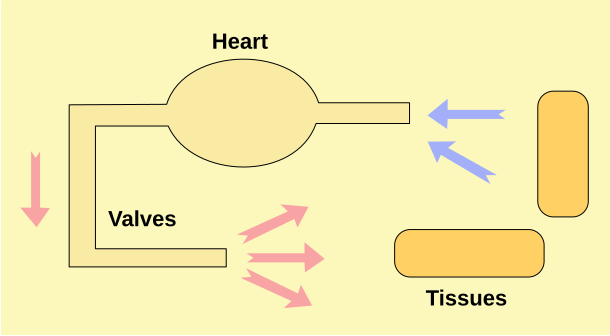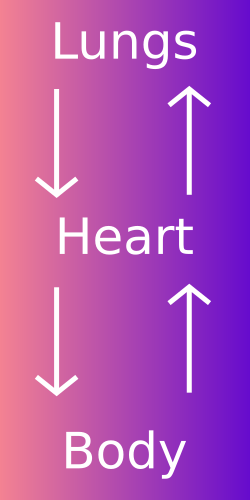OCR Specification focus:
‘Compare single and double circulations, and open versus closed systems, using insects, fish and mammals to illustrate structural and functional differences.’
Circulatory systems transport vital substances like oxygen and nutrients while removing metabolic wastes. Structural differences across taxa reflect evolutionary adaptations to body size, metabolic rate, and habitat.
Overview of Circulatory Systems
All multicellular animals require efficient transport systems to move substances rapidly across their bodies. These systems overcome the limitations of diffusion alone, which becomes inadequate as organisms increase in size and metabolic demand.
Circulatory systems consist of:
A transport medium (e.g. blood or haemolymph)
Vessels to carry the medium
A pumping mechanism, usually a heart, to maintain flow and pressure
Open Circulatory Systems
Structure and Function
In an open circulatory system, the transport medium is not entirely enclosed within vessels. Instead, it flows freely through body cavities, directly bathing organs and tissues.
Open circulatory system: A circulatory system in which the transport fluid leaves vessels and directly bathes body tissues in open spaces called sinuses.
Found mainly in invertebrates, such as insects, crustaceans, and some molluscs.
The heart pumps haemolymph (a mixture of blood and tissue fluid) into open spaces called haemocoels.
Exchange occurs between haemolymph and tissues without a dedicated capillary network.
After exchange, haemolymph returns to the heart via ostia (small openings).
Characteristics
Low pressure and slow flow: limits oxygen delivery to tissues.
No distinction between blood and tissue fluid.
Limited control over flow distribution — activity levels or posture can affect delivery rates.
Example: Insect Circulatory System
Insects possess a dorsal tubular heart running along the thorax and abdomen.
Valves within the heart ensure unidirectional flow.
Haemolymph transports nutrients, hormones, and waste but not oxygen, as gas exchange occurs via the tracheal system.

Diagram of an open circulatory system, showing haemolymph leaving vessels to bathe tissues in sinuses (haemocoel) and returning to the dorsal heart via ostia. Flow arrows emphasise low-pressure, diffuse distribution typical of insects. This figure focuses on the open layout rather than gas exchange, which insects handle via the tracheal system. Source.
Periodic heart contractions move haemolymph forward, with some assistance from body movement.
Closed Circulatory Systems
Structure and Function
In a closed circulatory system, blood remains entirely within vessels — arteries, veins, and capillaries — allowing greater pressure and faster flow.
Closed circulatory system: A circulatory system in which blood is contained within vessels and does not directly bathe body tissues.
Exchange occurs through capillary walls, where substances move between blood and tissue fluid via diffusion.
Blood composition remains distinct from tissue fluid, allowing precise regulation of composition and flow.
Found in annelids (e.g. earthworms), fish, and mammals.
Advantages
Higher pressure enables faster circulation, supporting active lifestyles.
Efficient distribution of oxygen and nutrients to specific tissues.
Control mechanisms (e.g. vasoconstriction and vasodilation) regulate blood flow depending on metabolic needs.
Single Circulatory Systems
Description
In a single circulatory system, blood passes through the heart once per complete circuit of the body.
Single circulatory system: A system where blood flows through the heart only once during each complete circulation of the body.
Common in fish.
The heart pumps deoxygenated blood to the gills, where gas exchange occurs.
Oxygenated blood then flows directly to body tissues before returning to the heart.
Process
Ventricle → Gills → Body → Atrium
The blood pressure drops significantly as it passes through the capillaries of the gills, resulting in slower flow to body tissues.
Example: Fish Circulation
Fish have a two-chambered heart (one atrium, one ventricle).
Blood pressure is limited by resistance in gill capillaries, yet sufficient for ectothermic fish with lower oxygen demands.
Countercurrent exchange in the gills maintains efficient oxygen uptake despite lower pressure.
Double Circulatory Systems
Description
In a double circulatory system, blood passes through the heart twice per circuit — once to the lungs (pulmonary circulation) and once to the body (systemic circulation).
Double circulatory system: A system in which blood flows through the heart twice during one complete circulation, maintaining separate pulmonary and systemic circuits.
Found in mammals and birds, supporting high metabolic rates.
Oxygenated and deoxygenated blood are completely separated, maximising efficiency.

Double circulation in mammals separates pulmonary (right heart → lungs → left heart) and systemic (left heart → body → right heart) circuits. This arrangement maintains lower pressure in the lungs and higher pressure to the body, supporting high metabolic rates. The diagram focuses on circuit separation without extra histological detail. Source.
Process
Pulmonary circulation:
Right side of heart → lungs → oxygenation → returns to left side.
Systemic circulation:
Left side of heart → body tissues → oxygen used → returns deoxygenated blood to right side.
Advantages
High pressure maintained in systemic circulation for efficient nutrient and gas delivery.
Lower pressure in pulmonary circuit prevents lung damage.
Enables precise control of blood oxygen content and temperature.
Comparative Overview Across Taxa
Insects (Open Circulation)
Transport medium: Haemolymph
Gas exchange: Via tracheal system, not circulatory
Pressure: Low
Efficiency: Suitable for small body size and low metabolic rate
Fish (Single Circulation)
Heart chambers: Two
Flow path: Heart → Gills → Body → Heart
Blood pressure: Drops after gills, slower tissue delivery
Adaptation: Works for aquatic ectotherms with reduced energy needs
Mammals (Double Circulation)
Heart chambers: Four
Flow path: Right heart → lungs → left heart → body
Blood pressure: Maintained high in systemic circuit
Efficiency: Supports endothermy and sustained activity levels
Summary of Key Comparisons
Open vs Closed: Open systems are simple but less efficient; closed systems allow high pressure and targeted flow.
Single vs Double: Single circulation is energy-efficient but slower; double circulation ensures rapid oxygen delivery for high metabolism.
Evolutionary progression shows increasing complexity and efficiency, from open systems in insects to double closed systems in mammals, paralleling rising metabolic demands and organism size.
FAQ
In open circulatory systems, circulation is driven by rhythmic heart contractions and body movements. The heart pumps haemolymph into open sinuses, where it bathes tissues directly before returning via small openings (ostia).
Because pressure is low and there are no capillaries, the flow is aided by:
Peristaltic heart contractions
Body or limb movement compressing sinuses
Elastic recoil of body walls
These mechanisms ensure enough circulation for the relatively low metabolic demands of invertebrates like insects.
Fish are ectothermic, meaning they do not regulate internal body temperature metabolically, so their oxygen and energy demands are lower.
Their aquatic environment also provides buoyancy, reducing the energy needed for movement. A single circulation system delivers sufficient oxygen through gills to support their metabolism, even though blood pressure drops after passing through gill capillaries.
This simplicity conserves energy that would otherwise be used to power a more complex double system.
The evolution of double circulation enabled endothermy — maintaining a constant internal body temperature through metabolic heat.
Key advantages include:
Separation of oxygenated and deoxygenated blood, ensuring maximum oxygen delivery
High systemic pressure, allowing rapid transport to active tissues
Lower pulmonary pressure, protecting delicate lung tissue
These adaptations support sustained activity, high energy output, and survival in variable environments.
As animals increase in size, their surface area to volume ratio decreases, making diffusion alone insufficient for oxygen and nutrient delivery.
A closed circulatory system enables:
Faster transport over longer distances
Higher pressure to overcome tissue depth
Regulated flow, allowing redistribution to active organs
Smaller animals with low metabolic demands can survive with open systems, but larger, more complex animals require closed systems to maintain efficient exchange.
In open systems, the transport fluid is haemolymph, which mixes with tissue fluid and lacks specialised respiratory pigments in many insects. It mainly carries nutrients, hormones, and waste products.
In closed systems, blood remains within vessels and contains haemoglobin for oxygen transport, plasma for dissolved nutrients, and cells for immune defence.
This distinction allows closed systems to deliver oxygen rapidly and maintain separate internal environments, critical for high metabolic efficiency.
Practice Questions
Question 1 (2 marks)
State two structural differences between open and closed circulatory systems.
Mark Scheme:
Open systems have blood (haemolymph) that flows freely through body cavities / sinuses. (1 mark)
Closed systems keep blood entirely within vessels (arteries, veins, and capillaries). (1 mark)
Accept “open systems have low pressure, closed systems have high pressure” as an alternative for one mark if structural detail is implicit.
Question 2 (5 marks)
Explain how the structure and function of the circulatory systems in fish and mammals are adapted to their metabolic needs.
Mark Scheme:
Fish have a single circulatory system where blood passes through the heart once per circuit. (1 mark)
Blood flows heart → gills → body → heart, losing pressure in the gills. (1 mark)
This slower circulation is sufficient for ectothermic fish with lower oxygen and energy demands. (1 mark)
Mammals have a double circulatory system, with separate pulmonary and systemic circuits. (1 mark)
This allows high blood pressure in the systemic circuit and efficient oxygen delivery, meeting the high metabolic demands of endothermy. (1 mark)
Award full marks for clear comparison and linkage between structure, function, and metabolic requirements.

